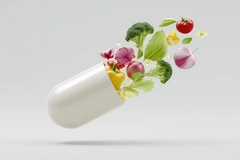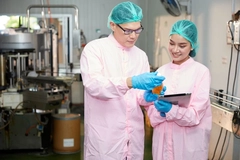Researchers highlight antioxidant and health properties of eight herbal extracts

26 Jun 2023 --- Medicinal plants exhibit antioxidant, antidiabetic, antimicrobial and cancer curative abilities due to their high content of polyphenols and flavonoids, according to an international team of researchers.
The team compared the composition and properties of eight plant extracts, investigating tea (Camellia sinensis), two types of mint (Mentha longifolia and Mentha arvensis), lemon grass (Cymbopogon citratus), fennel (Foeniculum vulgare) and three lesser-known medicinal plants, Tinospora cordifolia, Cassia absus and Trachyspermum ammi.
Polyphenols are plant compounds that act as antioxidants and antimicrobial agents. Flavonoids are polyphenols with higher antioxidant activity than other phenolic acids.
“These findings prove the therapeutic effectiveness of indigenous plants and highlight their importance as natural reserves of phytogenic compounds with untapped potential that needs to be discovered through advanced analytical methods,” highlight the study’s authors.
After cleaning, drying and grinding the plants, the research team processed the samples into extracts. They evaluated the extracts’ antioxidant, cytotoxicity and antimicrobial properties.
Study outcomes
While all extracts contained polyphenols, the concentration was the highest in tea, where phenolics were 20-116% higher than in the other plants.
 The researchers found that all plants had antioxidant properties from high polyphenol and flavonoid contents.T. ammi and C. citratus showed maximum cytotoxicity – toxic to cells – due to the presence of thymol compounds. According to the researchers, previous research demonstrated that these compounds have potential toxicity against cancer cells.
The researchers found that all plants had antioxidant properties from high polyphenol and flavonoid contents.T. ammi and C. citratus showed maximum cytotoxicity – toxic to cells – due to the presence of thymol compounds. According to the researchers, previous research demonstrated that these compounds have potential toxicity against cancer cells.
Tea and fennel extracts showed considerable antibacterial and enzyme inhibition activities, while M. arvensis also showed high enzyme inhibition properties.
The researchers gathered therapeutic uses of various plants by interviewing conventional medicinal practitioners and local people. They selected the eight plants based on ethnobotanical significance and authenticated their botanical identity through the National Herbarium of Pakistan.
Traditional medicinal uses for the plants include improving digestion (M. arvensis), tonic to cure colds (tea leaves with lemon extract), increasing appetite (fennel) and tonic to cure fevers (T. cordifolia).
The authors note that data on extracts’ toxicity and antidiabetic activity is limited, as are studies on isolating and identifying polyphenol polymers in the eight medicinal plants.
Antioxidant properties
All plants had antioxidant properties, mainly from their high polyphenol and flavonoid contents. M. arvensis and tea showed the highest antioxidant activities, while fennel and C. absus had the lowest antioxidant abilities.
Antioxidant activities were tested with various analyses, measuring the extracts’ free radical scavenging response – determining how well they neutralize different free radicals.
“Free radicals play a significant role in chronic diseases such as cancer, diabetes, cardiovascular diseases, arthritis and neural diseases,” explain the researchers.
“The present investigation also affirmed that the scavenging activity is directly proportional to the concentration of plant extracts. All plant samples showed maximum scavenging activity at 400 µg, which progressively declined with decreasing concentration until the slightest scavenging activity was observed at 50 µg,” add the authors.
The International Probiotics Association officially regards polyphenols as a prebiotic. As a result, ingredient companies are finding broader applications for the plant compounds and researching how they restore balance to the microbiome.
Phenolic compounds and flavonoids
Through Ultra-High-Performance Liquid Chromatography, the researchers found 25 polyphenol complexes in the eight plant extracts, categorized into phenolic acids, flavonoids and alkaloids.
About two-thirds of phenolics in plant-based foods are flavonoids. The researchers explain that phenolic acids are the primary polyphenols generated by plants, essential to absorb nutrients, build parts, enzyme activity, protein structure, photosynthesis and plant communication.
Tea exhibited the highest concentration of both phenolics and flavonoids, followed by wild mint (M. longifolia) and lemongrass.
“These phenolic compounds may improve foods’ shelf life and antimicrobial properties besides retention of color, taste and flavor,” note the researchers. The plants researched also exhibited antidiabetic, cytotoxic and antimicrobial properties.
The plants researched also exhibited antidiabetic, cytotoxic and antimicrobial properties.
They add: “Due to their antioxidant, anti-inflammatory, antimutagenic, anticarcinogenic and enzyme modulatory functions, flavonoids are essential components in various nutraceutical, pharmaceutical and cosmetic applications in today’s world.”
Polyphenols are linked to various health benefits. For example, Monteloeder’s EternalYoung has been shown to provide anti-aging skin benefits due to its blend of polyphenols, while the elderberry polyphenols in Iprona’s ElderCraft are promoted as prebiotics.
Inhibiting diseases with plants
The researchers note that plant extracts can act as antidiabetic agents as they inhibit α-glucosidase enzymes, which convert carbohydrates to glucose.
M. arvensis, tea and lemongrass inhibited α-glucosidase better than Acarbose, a commonly used medication for Type 2 diabetes.
All plant extracts showed bactericidal activity against tested microorganisms – Salmonella enterica, Staphylococcus aureus, E. coli and Bacillus cereus – which the researchers state are the most common pathogens causing human foodborne illness.
Fennel extracts in different concentrations showed substantial activities against all four microorganisms, while T. cordifolia and M. longifolia could only prevent the growth of salmonella and staphylococcus bacteria.
M. arvensis also showed unusual antimicrobial activities. The researchers note that the plant’s flavonoids, phenols, tannins, alkaloids and glycoside components are the reason for its bactericidal, antioxidant and cytotoxic characteristics.
The researchers determined plants’ cytotoxic profiles to assess their role in cancer treatment. T. ammi extracts exhibited maximum cytotoxicity at the lost extract concentrations.
“The results of the present investigation confirm that therapeutic plant extracts can play a significant role in cancer therapy due to their distinct cytotoxic abilities and rich phytochemical composition,” note the researchers.
Earlier research identified that a green Mediterranean diet, higher in dietary polyphenols and lower in red and processed meats, could reduce the risk of neurological conditions by lowering weight and brain age.
By Jolanda van Hal












